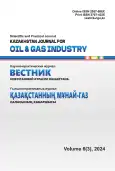Опробование функциональных возможностей программного обеспечения OLGA для определения оптимальных режимов транспортировки нефти, препятствующих выпадению твёрдых частиц
- Авторы: Ерлепесов М.У.1, Зайцев О.И.2, Ермеков А.А.1, Амиров С.К.1, Урбисинов Ж.С.1
-
Учреждения:
- Филиал ТОО «КМГ Инжиниринг» «КазНИПИмунайгаз»
- Филиал компании "Шлюмберже Лоджелко Инк." в Республике Казахстан
- Выпуск: Том 6, № 3 (2024)
- Страницы: 82-93
- Раздел: Транспорт нефти и газа
- URL: https://bakhtiniada.ru/2707-4226/article/view/266875
- DOI: https://doi.org/10.54859/kjogi108728
- ID: 266875
Цитировать
Полный текст
Аннотация
Обоснование. В процессе эксплуатации все механические примеси, попадающие в коллектор через выкидные линии, оседают на дно вследствие снижения скорости потока, что приводит к уменьшению пропускной способности трубопроводной сети системы сбора, дальнейшему росту давления, а также к преждевременному износу оборудования. Для решения данной проблемы необходимо иметь представление о динамике и интенсивности образования осадка на дне трубопровода.
Цель. Оценить функциональные возможности и эффективность применения динамического симулятора мультифазного потока для решения задач, связанных с транспортом скважинной жидкости с наличием твёрдых частиц.
Материалы и методы. Для построения математической симуляции мультифазного потока с наличием твёрдых частиц в специализированном программном комплексе OLGA в качестве объекта исследования выбран один из нефтесборных коллекторов месторождения N с диаметром 159×10 мм и длиной 1600 м, сбор скважинной продукции в котором осуществляется с 16 скважин. При моделировании процессов с помощью симулятора OLGA обеспечивалось измерение параметров движения потока с различными диаметрами частиц и прогнозирование динамики параметров, таких как изменяющиеся во времени скорости потока, состав флюида, температуры и процесс осаждения твёрдых частиц.
Результаты. Для потока с диаметром частиц 104 мкм активное выпадение осадка происходит при расходах от 200 до 300 м³/сут. Начиная с расхода 400 м³/сут, поток достигает достаточной скорости, чтобы выносить частицы без существенного накопления в рассматриваемом трубопроводе. Вынос песка при расходе от 400 до 500 м³/сут происходит неравномерно, т.к. твёрдая фаза транспортируется в режиме подвижного осадка, который периодически накапливается в песчаную «пробку», увлекается потоком и выносится из трубопровода. Частицы с диаметром 150 мкм активно выпадают в осадок при расходах от 200 до 400 м³/сут; начиная с расхода 500 м³/сут, поток достигает достаточной скорости, чтобы выносить частицы без существенного накопления в рассматриваемом трубопроводе.
Заключение. Программа позволила выполнить расчёт динамической системы для различных диаметров твёрдых частиц в мультифазном потоке и решить поставленную задачу по оценке динамики накопления твёрдой фазы в трубопроводе и определению скорости потока флюида, необходимой для предотвращения образования осадка. Программа применима для реализации имитационного моделирования при формировании технических решений с целью минимизации рисков осаждения твёрдых частиц в нефтесборных трубопроводах при эксплуатации объектов наземной инфраструктуры.
Полный текст
Открыть статью на сайте журналаОб авторах
Мурат Усенович Ерлепесов
Филиал ТОО «КМГ Инжиниринг» «КазНИПИмунайгаз»
Автор, ответственный за переписку.
Email: m.yerlepessov@kmge.kz
ORCID iD: 0009-0007-8581-2786
Казахстан, г. Актау
Олег Игоревич Зайцев
Филиал компании "Шлюмберже Лоджелко Инк." в Республике Казахстан
Email: OZaitcev2@slb.com
ORCID iD: 0009-0002-0443-655X
Казахстан, г. Атырау
Абай Алматаевич Ермеков
Филиал ТОО «КМГ Инжиниринг» «КазНИПИмунайгаз»
Email: A.Yermekov@kmge.kz
ORCID iD: 0009-0003-2130-2489
Казахстан, г. Актау
Саин Кубейсинович Амиров
Филиал ТОО «КМГ Инжиниринг» «КазНИПИмунайгаз»
Email: s.amirov@kmge.kz
ORCID iD: 0009-0005-7771-5535
Казахстан, г. Актау
Жугинис Сытдыйхович Урбисинов
Филиал ТОО «КМГ Инжиниринг» «КазНИПИмунайгаз»
Email: Zh.Urbissinov@kmge.kz
ORCID iD: 0009-0008-9723-5565
Казахстан, г. Актау
Список литературы
- Tao Y, Chen J, Liu J. Application and Practice of Integrated Sand Control Technology in Shallow Heavy Oil Reservoirs in Kazakhstan // SPE Annual Caspian Technical Conference; Ноябрь 15–17, 2022; Астана, Казахстан. Режим доступа: https://onepetro.org/SPECTCE/proceedings-abstract/22CTC/1-22CTC/514602. Дата обращения: 14.09.2023.
- Тахерифард А., Елистратов В.В. Численное моделирование эрозии в трубе при многофазном потоке нефти и газа // Известия ВНИИГ им. Б.Е. Веденеева. 2023. Том 307. С. 16–28.
- Solnordal C.B., Wong C.Y., Boulanger J. An experimental and numerical analysis of erosion caused by sand pneumatically conveyed through a standard pipe elbow // Wear. 2015. Vol. 336–337. P. 43–57. doi: 10.1016/j.wear.2015.04.017.
- Pereira G.C., de Souza F.J., de Moro Martins D.A. Numerical prediction of the erosion due to particles in elbows // Powder Technology. 2014. Vol. 261. P. 105–117. doi: 10.1016/j.powtec.2014.04.033.
- Zhang Y., Reuterfors E.P., McLaury B.S., et al. Comparison of computed and measured particle velocities and erosion in water and air flows // Wear. 2007. Vol. 263, Issue 1–6. P. 330–338. doi: 10.1016/j.wear.2006.12.048.
- Najmi K., McLaury B.S., Shirazi S.A., Cremaschi S. Low concentration sand transport in multiphase viscous horizontal pipes: An experimental study and modeling guideline // AIChE J. 2016. Vol. 62. P. 1821–1833. doi: 10.1002/aic.15131.
- Wicks M. Transport of solids at low concentration in horizontal pipes // Advances in Solid-Liquid Flow in Pipes and Its Application; March 4–6, 1968; Pennsylvania, PA. Режим доступа: https://trid.trb.org/view/19654. Дата обращения: 12.12.2023.
- al-Mutahar F. Modeling of Critical Deposition Velocity of Sand in Horizontal and Inclined Pipes : MSc Thesis. Tulsa : Department of Mechanical Engineering, The University of Tulsa, 2006.
- Обеспечение стабильности потока. ПО «OLGA». Руководство пользователя. Компания Schlumberger, 2023.
- Ермеков А.А., Баспаева А.Т., Амиров С.К. Применение моделирования для оптимизации системы нефтесбора месторождения N // Вестник нефтегазовой отрасли Казахстана. 2023. Том 5, №1. С. 94–102. doi: 10.54859/kjogi108599.
Дополнительные файлы



















